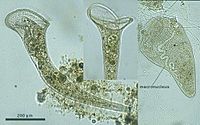Stentor facts for kids
Quick facts for kids Stentor |
|
|---|---|
 |
|
| Stentor roeseli | |
| Scientific classification | |
| Domain: | |
| Kingdom: | |
| Superphylum: | |
| Phylum: | |
| Class: |
Heterotrichea
|
| Order: |
Heterotrichida
|
| Family: |
Stentoridae
|
| Genus: |
Stentor
Lorenz Oken, 1815
|
Stentor is a fascinating group of tiny, single-celled creatures. They are a type of ciliate, which means they have tiny hair-like structures called cilia all over their bodies. Stentor are famous for their unique horn or trumpet shape. They can grow up to 2 millimeters long, which makes them one of the largest single-celled organisms known! Because of their shape, people used to call them trumpet animalcules.
Contents
What is a Stentor?
Stentor are a kind of protist. Protists are a diverse group of simple eukaryotic organisms, which means their cells have a nucleus and other special parts. Stentor belong to a group of ciliates called Heterotrichea. They live in freshwater environments like ponds and lakes.
Body and Features
The body of a Stentor looks like a horn or a bell. At the wider, open end, there is a ring of long, strong cilia. These cilia constantly beat, creating a current that sweeps food particles into the Stentor's mouth. They also help the Stentor swim through the water.
How Stentor Stays Healthy
Like many freshwater organisms, Stentor has a special part called a contractile vacuole. This vacuole works like a tiny pump. Water from the outside environment is less salty than the inside of the Stentor's cell. Because of this difference, water naturally flows into the cell through a process called osmosis. The contractile vacuole collects this extra water and then squeezes it out of the cell. This keeps the Stentor from swelling up and bursting.
Amazing Regeneration
Stentor have an amazing ability to regenerate. If a Stentor is cut into small pieces, each piece can often grow back into a complete, full-sized organism! This shows how tough and adaptable these tiny creatures are.
Cell Nuclei
Inside each Stentor cell, there are two types of nuclei:
- A large, often stretched-out macronucleus. This nucleus controls the everyday activities of the cell.
- Several smaller micronuclei. These are involved in the Stentor's reproduction and genetic processes.
Having these two different types of nuclei is a special feature of ciliates like Stentor.
See also
- Esténtor para niños (Stentor for kids in Spanish)

